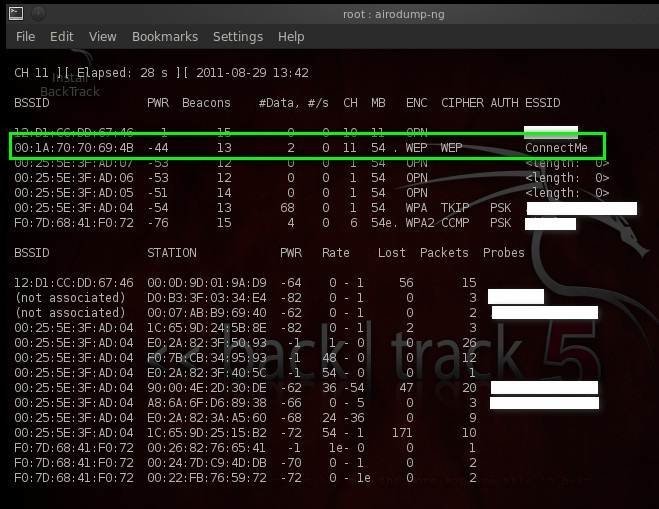1) First of all we have to find a wireless access point along with its bssid, essid and channel number. To do this we will run kismet by opening up the terminal and typing in kismet. It may ask you for the appropriate adapter which in my case is ath0. You can see your device’s name by typing in the command iwconfig.
2) To be able to do some of the later things, your wireless adapter must be put into monitor mode. Kismet automatically does this and as long as you keep it open, your wireless adapter will stay in monitor mode.
3) In kismet you will see the flags Y/N/0. Each one stands for a different type of encryption. In our case we will be looking for access points with the WEP encryption. Y=WEP N=OPEN 0=OTHER(usually WAP).
4) Once you find an access point, open a text document and paste in the networks broadcast name (essid), its mac address (bssid) and its channel number. To get the above information, use the arrow keys to select an access point and hit to get more information about it.
5) The next step is to start collecting data from the access point with airodump. Open up a new terminal and start airodump by typing in the command.
airodump-ng -c [channel#] -w [filename] –bssid [bssid] [device]
In the above command airodump-ng starts the program, the channel of your access point goes after -c , the file you wish to output the data goes after -w , and the MAC address of the access point goes after –bssid. The command ends with the device name. Make sure to leave out the brackets.
6) Leave the above running and open another terminal. Next we will generate some fake packets to the target access point so that the speed of the data output will increase. Put in the following command:
aireplay-ng -1 0 -a [bssid] -h 00:11:22:33:44:55:66 -e [essid] [device]
In the above command we are using the airplay-ng program. The -1 tells the program the specific attack we wish to use which in this case is fake authentication with the access point. The 0 cites the delay between attacks, -a is the MAC address of the target access point, -h is your wireless adapters MAC address, -e is the name (essid) of the target access point, and the command ends with the your wireless adapters device name.
7) Now, we will force the target access point to send out a huge amount of packets that we will be able to take advantage of by using them to attempt to crack the WEP key. Once the following command is executed, check your airodump-ng terminal and you should see the ARP packet count to start to increase. The command is:
aireplay-ng -3 -b [bssid] -h 00:11:22:33:44:5:66 [device]
In this command, the -3 tells the program the specific type of attack which in this case is packet injection, -b is the MAC address of the target access point, -h is your wireless adapters MAC address, and the wireless adapter device name goes at the end.
Once you have collected around 50k-500k packets, you may begin the attempt to break the WEP key. The command to begin the cracking process is:
aircrack-ng -a 1 -b [bssid] -n 128 [filename].ivs
In this command the -a 1 forces the program into the WEP attack mode, the -b is the targets MAC address, and the -n 128 tells the program the WEP key length. If you don’t know the -n , then leave it out. This should crack the WEP key within seconds. The more packets you capture, the bigger chance you have of cracking the WEP key.
Now you have learn how to hack wi-fi network.
This is the most practically way to hack wi-fi network working genuinely.Always put your try and i am sure this tutorial is helpful to you.
Comments





